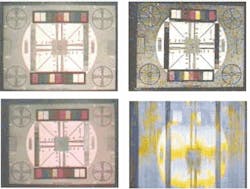CID camera tackles tough environments
Nuclear reactors are aging, and there is concern that key reactor components may be degrading in unexpected ways because of both chemical and radiation damage. It is, therefore, necessary to inspect these components underwater at or near the reactor core. Unfortunately, conventional CCD cameras succumb to radiation damage very quickly. Even when the reactor is shut down, the residual radiation is still strong enough to destroy these cameras after a relatively short time.
"Previous radiation-tolerant cameras could not view in color, or the color was of poor quality," says Jack Roberts, president of Symphotic TII (Camarillo, CA, USA; www.symphotic.com), a developer of radiation-hardened cameras. To address the demands of the nuclear power industry, the company developed a radiation-hardened underwater inspection camera, dubbed the AquaRAD, in conjunction with a consortium of companies including Roper Resources (Victoria, BC, Canada; www.roperresources.com), Japan Nuclear Fuel Industries (Tokyo, Japan; www.jnfl.co.jp), Spectra-Physics CIDTEC division (Liverpool, NY, USA; www.spectraphysics.com), and Inuktun Services (Nanaimo, BC, Canada; www.inuktun.com).
Designed for underwater applications such as nuclear refueling and nuclear-power-plant inspections, the camera is based on a novel solid-state imager: the charge-injection device (CID). "In developing these cameras," says Roberts, "CCD-based imagers could not be used because of the high level of radiation present in these applications." In CCD devices, high-energy reactor radiation results in the generation of surface trap sites near the device semiconductor and insulator interface. These trap sites rapidly accumulate the desired photon-generated charge, but the sites do not easily release the charge—a phenomenon known as bulk trapping. This photon-generated charge is so efficiently trapped that it cannot be properly transferred to the readout amplifier at the corner of the CCD device. This results in inaccurate and essentially unusable images from the radiation-damaged CCD.
The photon-generated charge is read out using a fundamentally different mechanism from the CID. With these devices, the photon-generated charge is transferred between electrodes within the pixel site, and the signal is quantified by sensing the voltage change on the sense electrode caused by this intrasite charge movement. Accordingly, any radiation-induced trap sites affect a single pixel only as opposed to the failure to read entire columns or rows as is encountered with CCD devices. In addition, the CID is constructed using a special proprietary radiation-hardened process, and therefore, it is more immune to radiation damage.
"We chose the CID color imager and camera electronics developed by CIDTEC in cooperation with Nuclear Fuels Industries. This imager is the world's only solid-state color imager that is capable of tolerating absorbed doses of more than 1 MegaRAD," says Roberts.
Both aluminum- and stainless-steel-clad housings can be supplied for the camera system. The aluminum housing is less expensive and is suitable for use in most applications. In addition, it has superior heat conductivity, allowing the camera to be used in higher-temperature environments. For limited diameter applications, Symphotic TII's AquaRAD SL camera uses a small-diameter stainless-steel-clad housing. The company is also developing a right-angle viewer for the AquaRAD SL camera, scheduled for delivery this month.
Built into the camera is a ring of white LED lights that provides illumination of the target scene. "The LED lighting is our own design," says Roberts, "that uses commercially available LEDs tested to more than 1-megaRAD absorbed dose to evaluate color changes and intensity loss in the radiation environment. In these tests, the LEDs showed no significant change due to radiation damage." For ease of maintenance, the camera is built in three parts: a lens and lighting module, the radiation-hardened CID imager module, and a cable connector. This design allows each individual component to be replaced as necessary.
The cameras have standard video outputs to transfer image data in NTSC format to a remote frame grabbers. Interface to a conventional PC is accomplished using a commercially available video capture device, connected by a USB 2.0 port or FireWire. The interface cable was designed by Symphotic TII and NFI, to meet the requirements of customers such as GE Nuclear Energy (Atlanta, GA, USA; www.gepower.com) and Areva (Paris, France; www.areva.com). According to Roberts, this cable is built in bulk with waterproof connectors by Birns (Oxnard, CA, USA; www.birns.com).

